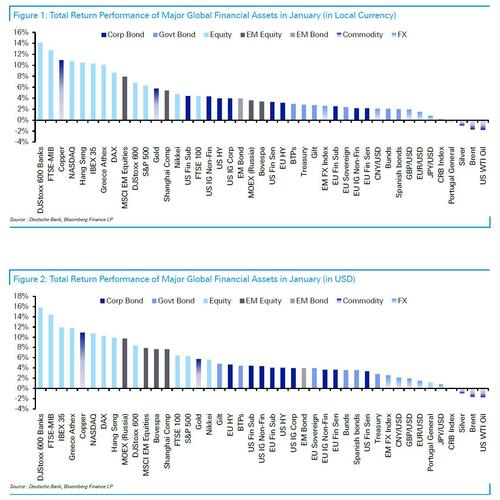


Markets got the year off to a stellar start in January, with a positive performance for 34 of the 38 non-currency assets tracked by Deutsche Bank thematic research group. In fact, in terms of the breadth of gains, that’s the strongest start to a year since 2019, with advances across equities, sovereign bonds and credit. The main exception to this pattern has been among energy commodities, but lower oil and gas prices have themselves been good news to consumers who’ve been squeezed by higher energy prices last year.
Elsewhere, As DB's Henry Allen writes, Chinese assets have continued to perform strongly amidst the economy’s reopening, which has also supported a strong rally amongst industrial metals. Nevertheless, it hasn’t been all good news, with investors remaining nervous about a US recession, as well as the prospect of more persistent inflation.
Below we share some more details from the latest DB January performance review
Month in Review - The high-level macro overview
2023 got off to a positive start in January, with investor risk appetite supported by several good news stories. The most important was the decline in energy prices, particularly in Europe, where natural gas futures continued their decline from late December with a further -24.8% decline in January. That took them down to their lowest levels since September 2021, and means that the outlook for the European economy is much brighter than expected only a few weeks ago, prompting numerous economists to positively revise their forecasts and remove a Euro Area recession from their 2023 projections. This brightening picture has also been reflected in sentiment indicators, with the European Commission’s numbers for Euro Area consumer confidence at an 11-month high in January.
The other positive story for markets in January was the continued reopening of China’s economy. Easing restrictions have made investors more optimistic on China’s economic performance, with the Shanghai Composite up +5.4% in total return terms. And more broadly, industrial metals prices have performed very strongly, with copper (+10.9%) advancing for a third consecutive month, raising concerns that China’s reopening could be inflationary for the global economy.
The brighter macro outlook meant that various assets put in a very strong performance over January. For instance, the S&P 500 (+6.3%) had its best start to a year since 2019, and Europe’s STOXX 600 (+6.8%) had its best start since 2015. Meanwhile for US Treasuries (+2.8%), it’s been their second-best monthly performance since March 2020, back when the Fed slashed rates to zero as the Covid pandemic began. Tech stocks saw a particularly strong performance following an awful 2022, with the FANG+ index of 10 megacap tech stocks up by +18.7%, marking its best month since August 2020.
However, a more negative story over the month has been continued fears about a US recession. These were present from the start of the month, when the ISM readings showed that December was the first month since May 2020 that both the services and manufacturing components were in contractionary territory. Then both the retail sales and industrial production data for December came in beneath expectations. And lastly, the Conference Board’s Leading Index showed a year-on-year decline of -6.0%, which historically has been consistent with either recessions or the recovery from recessions. Other leading indicators such as the yield curve remained deeply inverted too, with the 2s10s closing in inversion territory for a 7th consecutive month.
A final theme over the month was growing speculation that central banks might be nearing an end to their current cycle of rate hikes. That was turbocharged by the weak ISM services index for December at the start of the month, and then the US CPI release for December cemented expectations that the Fed would downshift to a 25bps move at their February meeting. Similar themes were evident elsewhere, with the Bank of Canada formally announcing a pause in their rate hikes for the time being. That said, nervousness about stronger-than-expected inflation was still evident, and the end of the month saw a modest sell-off on the penultimate day amidst fears that the central bank meetings in February could see a continuation of their hawkish stance.
Which assets saw the biggest gains in January?
Which assets saw the biggest losses in January?

